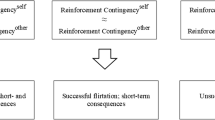Abstract
Dysfunctional control exerted by reason-giving in adult psychopathology is interpreted from a radical behavioral perspective. Verbal-social contingencies which support the establishment of reason-giving and its control over maladaptive actions are reviewed. A contextual approach to psychotherapy, comprehensive distancing, which attempts to weaken dysfunctional verbal control is described briefly. Data relevant to therapeutic process are presented. The overall results suggest that comprehensive distancing facilitates therapeutic change through a process consistent with a behavioral analysis of reason-giving. Suggestions for further research and radical behavioral approaches to psychotherapy are discussed.
Similar content being viewed by others
References
Beck, A. T. (1976). Cognitive therapy and the emotional disorders. New York: International Universities Press.
Beck, A. T., Rush, A. J., Shaw, B. F., & Emery, G. (1979). Cognitive therapy of depression. New York: Guilford.
Bem, D. J. (1972). Self-perception theory. In L. Berkowitz (Ed.), Advances in experimental social psychology (Vol. 6, pp. 2–62). New York: Academic Press.
Bentall, R. P., Lowe, C. F., & Beasty, A. (1985). The role of verbal behavior in human learning: II. Developmental differences. Journal of the Experimental Analysis of Behavior, 43, 165–181.
Catania, A. C., Matthews, B. A., & Shimoff, E. (1982). Instructional versus shaped human verbal behavior: Interactions with nonverbal responding. Journal of the Experimental Analysis of Behavior, 38, 233–248.
Deitz, S. M. (1985, May). Understanding the mental idioms in children’s language. Paper presented at the annual convention of the Association for Behavior Analysis, Columbus, OH.
Devany, J. M., Hayes, S. C., & Nelson, R. O. (in press). Stimulus equivalence in language able and disabled children. Journal of the Experimental Analysis of Behavior.
Ellis, A. (1962). Reason and emotion in psychotherapy. Secaucus, NJ: Stuart.
Ellis, A. (1973). Humanistic psychotherapy. New York: McGraw-Hill.
Ericsson, K. A., & Simon, H. A. (1984). Protocol analysis: Verbal reports as data. Cambridge, MA: MIT Press.
Ferster, C. B. (1972). An experimental analysis of clinical phenomena. The Psychological Record, 22, 1–16.
Ferster, C. B. (1979a). A laboratory model of psychotherapy: The boundary between clinical practice and experimental psychology. In P. O. Sjoden, S. Bates, & W. S. Dockens III (Eds.), Trends in behavior therapy (pp. 23–38). New York: Academic Press.
Ferster, C. B. (1979b). Psychotherapy from the standpoint of a behaviorist. In J. D. Keehn (Ed.), Psychopathology in animals: Research and clinical implications (pp. 279–303). New York: Academic Press.
Glenn, S. S. (1983). Maladaptive functional relations in client verbal behavior. The Behavior Analyst, 6, 47–56.
Hamilton, M. (1960). A rating scale for depression. Journal of Neurology, Neurosurgery, and Psychiatry, 23, 56–61.
Hayes, S. C. (in press). A contextual approach to therapeutic change. In N. Jacobson (Ed.), Cognitive and behavior therapies in clinical practice. New York: Guilford.
Hayes, S. C., & Brownstein, A. J. (1986). Mentalism, behavior-behavior relationships, and the purpose of science. Unpublished manuscript, University of North Carolina at Greensboro.
Hayes, S. C., Brownstein, A. J., Zettle, R. D., Rosenfarb, I., & Korn, Z. (in press). Rule-governed behavior and sensitivity to changing contingencies. Journal of the Experimental Analysis of Behavior.
Hollon, S. D., & Kendall, P. C. (1980). Cognitive self-statements in depression: Development of an automatic thoughts questionnaire. Cognitive Therapy and Research, 4, 383–395.
Layng, T. V. J., & Andronis, P. T. (1984). Toward a functional analysis of delusional speech and hallucinatory behavior. The Behavior Analyst, 7, 139–156.
Mahoney, M. A (1974). Cognition and behavior modification. Cambridge, Mass.: Ballinger.
Matthews, B. A., Catania, A. C., & Shimoff, E. (1985). Effects of uninstructed verbal behavior on nonverbal responding: Contingency descriptions versus performance descriptions. Journal of the Experimental Analysis of Behavior, 43, 155–164.
Nisbett, R. E., & Ross, L. (1980). Human inference: Strategies and shortcomings of social judgment. Englewood Cliffs, NJ: Prentice-Hall.
Nisbett, R. E. & Wilson, T. D. (1977). Telling more than we know: Verbal reports on mental processes. Psychological Review, 84, 231–259.
Rush, A. J., Beck, A. T., Kovacs, M., & Hollon, S. (1977). Comparative efficacy of cognitive therapy and pharmacotherapy in the treatment of depressed out-patients. Cognitive Therapy and Research, 1, 17–37.
Siegel, S. (1956). Nonparametric statistics for the behavioral sciences. New York: McGraw-Hill.
Skinner, B. F. (1953). Science and human behavior. New York: Free Press.
Skinner, B. F. (1957). Verbal behavior. Englewood Cliffs, NJ: Prentice-Hall.
Skinner, B. F. (1969). Contingencies of reinforcement: A theoretical analysis. New York: Appleton-Century-Crofts.
Skinner, B. F. (1974). About behaviorism. New York: Knopf.
Wynne, L. (1984, May). Issues in the assessment of psychotic speech. In S. Leigland (Chair), Implications of Skinner’s Verbal behavior for clinical assessment. Symposium conducted at the annual convention of the Association for Behavior Analysis, Nashville.
Zettle, R. D. (1980, November). Insight: Rules and revelations. In S. C. Hayes (Chair), The baby and the bathwater: Radical behavioral interpretations of traditional clinical phenomena. Symposium conducted at the annual convention of the Association for Advancement of Behavior Therapy, New York.
Zettle, R. D. & Hayes, S. C. (1982). Rule-governed behavior: A potential theoretical framework for cognitive-behavioral therapy. In P. C. Kendall (Ed.), Advances in cognitive-behavioral research and therapy (Vol. 1, pp. 73–118). New York: Academic Press.
Zettle, R. D., & Hayes, S. C. (1984, August). Cognitive therapy of depression: Behavioral analysis of component and process issues. In S. C. Hayes (Chair), Behavior analytic perspectives on current issues in clinical psychology. Symposium conducted at the 92nd annual convention of the American Psychological Association, Toronto.
Author information
Authors and Affiliations
Rights and permissions
About this article
Cite this article
Zettle, R.D., Hayes, S.C. Dysfunctional control by client verbal behavior: The context of reason-giving. Analysis Verbal Behav 4, 30–38 (1986). https://doi.org/10.1007/BF03392813
Published:
Issue Date:
DOI: https://doi.org/10.1007/BF03392813




